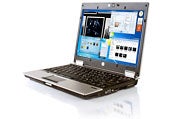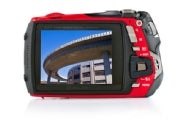 The best of the Droids on Verizon, the Droid Incredible ($200 with a two-year contract from Verizon) impresses with its speedy user interface, gorgeous AMOLED display and fun Sense user interface. Other than some minor design qualms, this smartphone truly lives up to its name.
The best of the Droids on Verizon, the Droid Incredible ($200 with a two-year contract from Verizon) impresses with its speedy user interface, gorgeous AMOLED display and fun Sense user interface. Other than some minor design qualms, this smartphone truly lives up to its name.Design-wise, the Droid Incredible appears fairly similar to the Nexus One, but it is essentially a CDMA version of the HTC Desire, which launched last February in Barcelona, Spain. The Droid Incredible has an 8-megapixel camera (as opposed to the Nexus One and Desire's 5-megapixel shooters). The Droid Incredible also has a strange rubberdized "topographic" battery cover, which I could have done without. While the Incredible is lighter, it doesn't feel as solid as the Nexus One.
While the Nexus One has four touch keys, the Droid Incredible has four physical hardware keys running along the bottom (Home, Menu, Back, Search). I actually prefer the Nexus One's touch keys, though, as it gives the phone a more streamlined look.
Another difference from the Nexus One is that the Droid Incredible has an optical mouse as opposed to a trackball. Like RIM BlackBerrys, HTC seems to be making a shift from trackball to optical (both the HTC Desire and Legend sport an optical mouse).
The Droid Incredible runs Android 2.1 with the revamped Sense interface, which offers some useful new functions for easy navigation. For more information about Android 2.1's features, check out our review of the Google Nexus One.
Impressive 8-Megapixel Camera
While 5-megapixel cameras seems to be the standard for high-end smartphones for right now, expect to see a lot more 8-megapixel camera phones in the near feature. Overall, I was impressed with the Droid Incredible's camera, but I didn't think it was as good as the Sony Ericsson XPERIA X10. You press the haptic mouse to snap pictures, which works okay, but I found myself wishing there was a dedicated camera key on the phone's spine. The phone just didn't feel as steady in my hands and sometimes my pictures looked a bit blurry. Otherwise, I was very impressed with my outdoor shots. Colors appeared bright and natural, details looked sharp. There was also very little shutter lag. My indoor shots looked good as well, though a few had a bit of yellowish tint. The flash also seemed a bit unpredictable as to when it decided to go off, as well. Many of my indoor shots were pretty well lit so when the flash went off, details and colors were blown out. Nighttime snapshots looked good, however-better than most smartphone cameras with flashes.
The Droid Incredible can shoot high resolution video up to 800-by-480, but you can't shoot 720p quality video. The camcorder is fine for quick clips, but I was disappointed by the slight pixelation in my videos.
Multimedia: Just Okay
I do wish that HTC would have updated the Sense media player. It is slightly prettier than the dull-as-dirt Android player, but I prefer iTunes or Palm's webOS player. Audio playback sounded good, though and the player supports a respectable range of audio and video formats.
from www.pcworld.com
Read More......
Another difference from the Nexus One is that the Droid Incredible has an optical mouse as opposed to a trackball. Like RIM BlackBerrys, HTC seems to be making a shift from trackball to optical (both the HTC Desire and Legend sport an optical mouse).
The Droid Incredible runs Android 2.1 with the revamped Sense interface, which offers some useful new functions for easy navigation. For more information about Android 2.1's features, check out our review of the Google Nexus One.
Impressive 8-Megapixel Camera
While 5-megapixel cameras seems to be the standard for high-end smartphones for right now, expect to see a lot more 8-megapixel camera phones in the near feature. Overall, I was impressed with the Droid Incredible's camera, but I didn't think it was as good as the Sony Ericsson XPERIA X10. You press the haptic mouse to snap pictures, which works okay, but I found myself wishing there was a dedicated camera key on the phone's spine. The phone just didn't feel as steady in my hands and sometimes my pictures looked a bit blurry. Otherwise, I was very impressed with my outdoor shots. Colors appeared bright and natural, details looked sharp. There was also very little shutter lag. My indoor shots looked good as well, though a few had a bit of yellowish tint. The flash also seemed a bit unpredictable as to when it decided to go off, as well. Many of my indoor shots were pretty well lit so when the flash went off, details and colors were blown out. Nighttime snapshots looked good, however-better than most smartphone cameras with flashes.
The Droid Incredible can shoot high resolution video up to 800-by-480, but you can't shoot 720p quality video. The camcorder is fine for quick clips, but I was disappointed by the slight pixelation in my videos.
Multimedia: Just Okay
I do wish that HTC would have updated the Sense media player. It is slightly prettier than the dull-as-dirt Android player, but I prefer iTunes or Palm's webOS player. Audio playback sounded good, though and the player supports a respectable range of audio and video formats.
from www.pcworld.com





